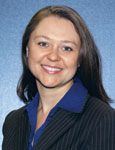Make yourself essential
How to become a must-have employee.
Jennifer Finn

Clinical charge coordinator
Veterinary Specialty Hospital of the Carolinas
Location: Cary, N.C.
First veterinary job: Customer service representative
Career path
After stints as a restaurant manager and streetlight salesperson, Finn wanted a job she could believe in. So when she saw an employment ad for a receptionist position at Veterinary Specialty Hospital of the Carolinas, she sent in her resume—three times. Her persistence paid off, and she's been working there for 10 years now.
Finn moved from customer service representative to group supervisor then to her current role: clinical charge coordinator, a brand-new position at the 24-hour practice that employs about 100 people. "Nurses enter charges for patients, but some of the fees were getting missed," Finn says. "We wanted to avoid having to send out invoices after patients were discharged, so this new position was created to maximize charge capture."
In about a year, Finn has saved around $120,000 in revenue. How does she do it? Before a patient is discharged, she pulls up the hospital's inventory records through its automated inventory management system and visits the digital radiography and laboratory providers' Web sites. This allows her to see which treatments and services the patient has received. She compares this information to the in-house flowchart and adds any missed charges.
Why managers love her
"Jennifer has been with the hospital for years," says Paige Phillips, RVT, chief of operations at Veterinary Specialty Hospital and a Firstline Editorial Advisory Board member. "She maintains a positive outlook in her position by her professionalism and belief in our hospital's core values."
Essential qualities
"As a customer service representative, when I had time, I'd read patients' discharge instructions and teach myself about their presenting problems and the related diagnostic tests and treatments," Finn said. "This way I could better serve pet owners when answering their phone calls and better assist the medical staff by ensuring clients had accurate instructions and information." This additional knowledge—as well as her follow-through and attention to detail—positioned her perfectly to take on extra responsibilities.
Marianne Mallonee

Hospital administrator and part owner
Wheat Ridge Animal Hospital
Location: Wheat Ridge, Colo.
First veterinary job: Technician assistant
Career path
Mallonee has worked in veterinary practices since high school. Every owner she's worked with along the way has encouraged her to learn about the business side of medicine. Although she had no formal management training, she landed a practice manager job. The owners valued Mallonee's role so much they sent her to countless CE programs, including two prestigious veterinary management schools.
Mallonee eventually set her sights on practice ownership. She moved to Colorado—a state that allows nonveterinarians to be owners—and found her current position at a facility that includes general, emergency, and specialty and referral practices and a team of 26 veterinarians and about 110 employees. Four years into the job, a few of the owners started planning their exit strategies. Mallonee took the bull by the horns. "I pulled the managing partner aside and told him I had an interest in becoming a partner," Mallonee says. "He kind of laughed and looked surprised. Then he got serious and said my name had come up. So I reiterated that I was making an official statement of interest."
To allow a nonveterinarian owner, the practice had to make a lot of changes, such as altering its bylaws, payment system, and corporate standing. But the process was worth it. "I'm proud to be an owner of Wheat Ridge," Mallonee says, "and I'm proud of the team for working to get us through tough financial times this year. I'm trying hard to keep making the practice a better place for our awesome team members and clients."
Why managers love her
"Marianne improved the management of our practice," says Dr. Donald Ostwald, DABVP, managing partner at Wheat Ridge. "She also developed an attribute that's critical for partners and that is putting the success of the practice over their own success."
Essential qualities
Even before she was an owner, Mallonee treated every practice as if it was her own. She shared the veterinarians' intense desire for the clinics to be the best they could be in order to create positive relationships between pets and people. As a result, she always works to identify areas of improvement. Then she's willing to make the necessary changes.
Brad Phifer, CPDT

Director of Pet Behavior Services
Broad Ripple Animal Clinic and Wellness Center Bark Tutor School for Dogs
Location: Indianapolis
First veterinary job: Kennel assistant
Career path
While working at the Indianapolis Humane Society, Phifer was asked to teach a puppy class. He did—with no training. This increased his passion for behavior and he started attending CE, including the DOGS! Course at the Purdue University Animal Behavior Clinic. With his knowledge, Phifer became director of the shelter's behavior program.
Later, Phifer started behavior consulting with Broad Ripple, which allowed him to grow into his current role. A few of his duties: Offering one-on-one behavior consultations and training, as well as maintaining the curriculum at Bark Tutor where he's head master. He also gives employees—including two kennel assistants turned canine training instructors—opportunities. "We have great staff members, so it makes sense to invest in them." Phifer says. "It's good for their careers and our organization and clients."
Why managers love him
"Brad is a visionary," says Brenda Tassava, CVPM, director of operations at Broad Ripple. "At our practice, we're constantly looking for new ways to accomplish goals and set new standards—and so is he."
Essential qualities
"I love pets, but I'm people-oriented because client relationships is what it's all about," Phifer says. "So I go above and beyond for my clients. If I can't give clients what they need, they're going to go somewhere else." This dedication to pet owners drives Phifer's communication approach. He builds trusting relationships with clients by listening intently, objectively assessing their situations, then telling them nicely—but authoritatively—what he recommends.
Tiah Schwartz, CVT

Client care team supervisor
Laurelhurst Veterinary Hospital
Location: Portland, Ore.
First veterinary job: Veterinary assistant
Career path
Helping at a spay and neuter clinic convinced Schwartz to attend technology school. Laurelhurst hired her knowing she'd be certified in two years. Nine years later, Schwartz was asked to switch from lead technician to front desk supervisor. "At first I was scared," Schwartz said. "I wondered whether I'd lose my technical skills and whether I'd be able to offer anything to the client care team. Then I started thinking about what it means to be a team player."
Schwartz was the resource the front desk needed. "The receptionists know their stuff," Schwartz says, "but it's nice for them to ask me a question without running all over to find a technician." Since Shwartz joined them up front, the receptionists attend more CE and there's been no client-care team turnover.
Why managers love her
"Tiah illustrates by example how to execute our mission," says Dr. Linda Ross, owner of Laurelhurst. "She's caring but provides firm direction, she knows and abides by our policies, and she's calm and focused in difficult situations."
Essential qualities
Schwartz follows this mantra: Every task belongs to everyone as long as it's within their capabilities. By putting her positive can-do attitude to work in any and every area of the hospital, Schwartz helps create a fun environment for team members and pet owners. And she's able to unite the front and back staffs, finding solutions that help the entire team.